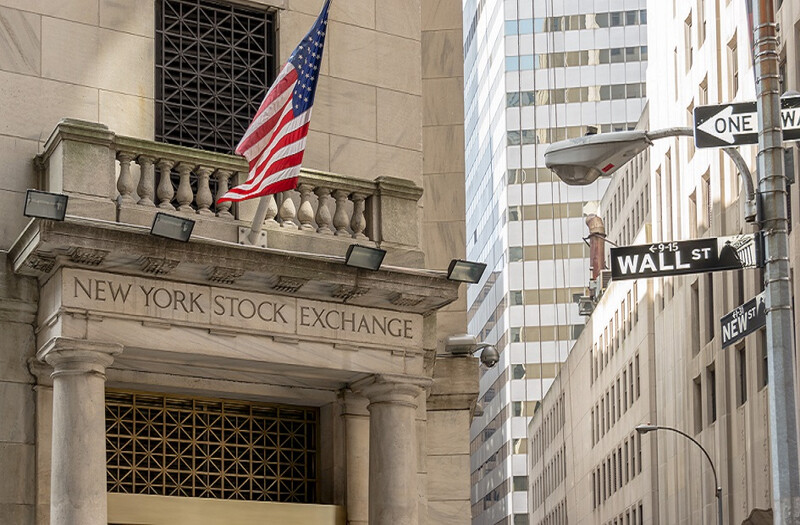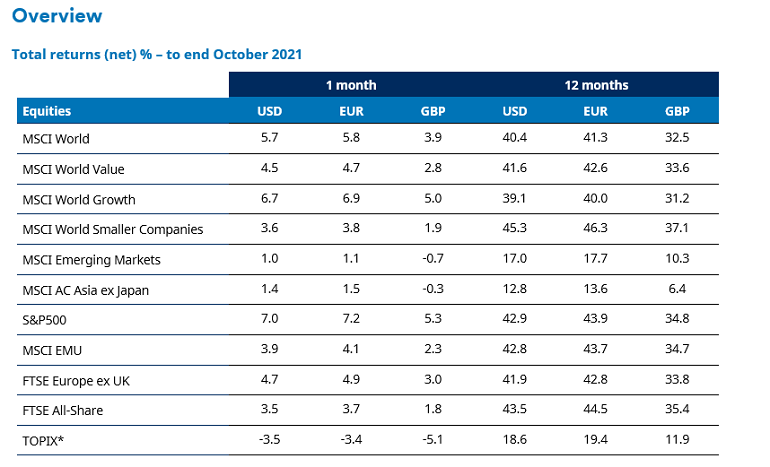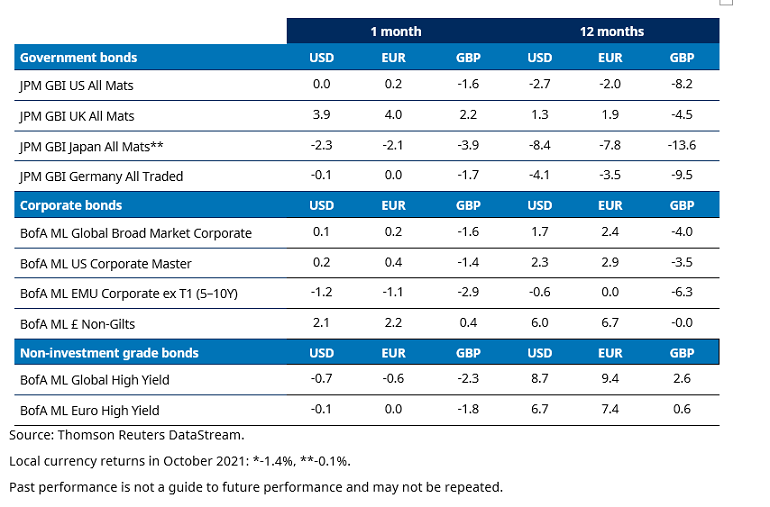Monthly markets review - October 2021
A look back at markets in October, when shares shrugged off worries over inflation to make further upward progress.

Authors
- Global stock markets gained in October, supported by encouraging corporate earnings and an easing of fears around China’s property sector.
- Government bond yields broadly rose as central banks indicated they were prepared to withdraw monetary policy accommodation in light of rising inflationary pressures.
- Commodities gained with the energy component performing strongly.
Please note any past performance mentioned is not a guide to future performance and may not be repeated. The sectors, securities, regions and countries shown are for illustrative purposes only and are not to be considered a recommendation to buy or sell.
US
US equities gained in October. Earnings releases were generally strong, with a positive update from Caterpillar – often seen as an economic bellwether – setting a positive tone. There were, however, notable disappointments from Apple and Amazon. Apple cited supply disruption – principally regarding chip availability – as responsible for softer revenues, while Amazon alluded to labour shortages adding to costs.
Economic data indicated a marked slowdown in activity. In Q3, US GDP growth was the slowest in over a year at an annualised 2.0% quarter-on-quarter, down from 6.7% in Q2. But data also suggested that consumer confidence is very high. Supply chain disruption and consequent shortages of big-ticket items such as vehicles appears to have curtailed spending more than a fall in demand.
The economic releases did not dissuade the Federal Reserve (Fed) from its plans to taper quantitative easing to a full stop by mid-next year. Elevated inflation figures are still held by the central bank to be transitory.
Some of the strongest returns in the month came from the consumer discretionary and energy sectors. Gains in the consumer staples and communication service sectors, while positive, were more muted.
Eurozone
Eurozone shares posted gains in October. The Q3 corporate earnings began in the month and showed ongoing evidence of strong demand, although cost pressures are also beginning to be felt. The top performing sectors included utilities, IT and consumer discretionary. Underperforming sectors included communication services and real estate.
The month brought soaring power prices amid shortages of natural gas. However, prices declined towards month end after Russian President Putin called for Gazprom to start filling European storage facilities. The Spanish government backed away from plans to impose a tax on “excess profits” made by utility companies. This helped the share prices of southern European utilities to rebound after steep falls in September.
Euro area annual inflation was estimated at 4.1% for October, up from 3.4% in September. However, the European Central Bank (ECB) reiterated that it expects the current spike in inflation to prove transitory. Meanwhile, Q3 GDP growth was 2.2%, compared to 2.1% in Q2.
Forward-looking data indicated that supply bottlenecks are starting to weigh on growth. The flash composite purchasing managers’ index (PMI) was 54.3 in October, a rate that still indicates economic expansion but is a six-month low. The PMI is based on company surveys, with a reading above 50 indicating expansion and below 50 indicating contrction.
In Germany, talks continued over the formation of the next governing coalition. It will likely comprise social democrats, greens and liberals and be led by Olaf Scholz, the current finance minister. There is also changing coming at the Bundesbank (Germany’s central bank) after Jens Weidmann said he would step down from his position as head of the bank at the end of this year.
UK
UK equities rose over October, helped by a strong start to the Q3 reporting season. Internationally focused sectors led the market higher, including financials, with banks in particular performing very well. Financials performed well amid growing expectations that the US Federal Reserve and Bank of England (BoE) would soon react decisively to rising inflationary pressures.
That large cap internationally focused banks recovered so well was reflective of how heavily influenced they are by short-term market interest rates in the US, which picked up markedly. Meanwhile, a number of UK large caps exposed to China also enjoyed something of a recovery, reversing some of their recent underperformance.
Expectations that the BoE might become the first of the world's major central banks to raise rates also, in part, explained the poor performance of a number of the UK domestically focused areas of the market. This was evident for the consumer-facing domestic sectors, such as housebuilders, and, more widely, was reflected in the underperformance of UK small and mid cap (SMID) equities.
Fears around the potential reimposition of restrictions as Covid infections picked up also weighed on the UK retailers, which continued to report supply disruptions, as evidenced by continued gaps on shop shelves. Signs of a recent recovery in economic momentum and some good news on the outlook for the economy within the Budget were insufficient to lift sentiment.
Japan
The Japanese stock market declined by 1.4% in October as investors digested the prospects for new prime minister Kishida, ahead of the general election which took place on 31 October. Global news flow was generally negative in the first half of October, especially from China, but the sustained strength of US markets provided some support for Japan. The yen continued to weaken against the US dollar, reaching levels last seen in late 2018.
Expectations for the ruling Liberal Democratic Party’s (LDP) election performance under Mr Kishida’s leadership were modest, with the party bracing itself to lose up to 40 seats. In the event the LDP lost only 15 seats and retained a solid majority in its own right. Together with seats gained by its partners, the ruling coalition retains majorities on all standing committees and therefore complete legislative control.
Although the headline results have considerably improved the stability of the new administration, the election was not all plain sailing. One of Mr Kishida’s key allies in the LDP lost his seat and the electorate also delivered a potentially important message in the strong gains made by the reform-oriented Ishin party.
The political focus will now shift to a substantial fiscal stimulus package, details of which should be announced later in November. This is likely to include direct cash handouts to households in an effort to kick-start a consumption recovery in the first half of 2022, following on from the lifting of the state of emergency at the end of September.
Economic data released in October provided few surprises, although the Bank of Japan’s own assessment has improved somewhat, despite caution over higher commodity prices and supply-chain constraints.
Asia (ex Japan)
Asia ex Japan equities rose in October. Shares rallied at the start of the month, driven by positive earnings guidance and an ongoing decline in the number of new Covid-19 cases in many countries in the region. However, shares were weaker towards the end of the month with ongoing concerns over rising energy prices and higher inflation weighing on investor sentiment. Continuing tensions between the US and China on a number of issues including Covid-19, cyber security and computer chips also dented market returns towards the end of October.
Pakistan was the best performing market in the index, reversing its position as the worst performing market a month earlier. Indonesia also recorded a robust performance in the month. China recorded a modestly positive performance, with property stocks rallying after real estate group Evergrande made an interest payment on its debt during the month, allaying fears over a potential default and spill over into the wider market. Stocks in Hong Kong also achieved modest gains during the month.
South Korea was the weakest index market during October as foreign and institutional investors took profits after quarterly earnings reached all-time highs. However, these losses were offset by gains from technology stocks as solid earnings boosted chip makers. Indian equities were also weaker during the month and underperformed the broader market in October as concerns over inflation weighed on investor sentiment and weaker tech stocks outweighed gains in banking stocks.
Emerging markets
Emerging market (EM) equities recorded a positive return in October. Egypt was the best performing market in the index, aided by strong performance from Commercial International Bank. Peru, where political concerns moderated, Argentina and Pakistan all posted robust returns and outperformed the index. Indonesia, a beneficiary of higher coal prices, Russia, Qatar, Saudi Arabia, and Kuwait outperformed amid energy price strength.
China also finished ahead of the broader index, driven by a pick-up in several internet and e-commerce stocks which were negatively impacted by regulatory actions earlier this year.
By contrast, Brazil registered a decline, amplified by currency weakness, and was the weakest market in the index. During the month the government announced additional welfare spending, raising concerns over the fiscal outlook. Meanwhile, with inflation climbing to 10.25% year-on-year, the central bank continued to tighten monetary policy, hiking its key interest rate by 150bps to 7.75%.
Chilean equities were also firmly down amid political uncertainty ahead of next month’s presidential election, and concerns over a fourth pension withdrawal. India and South Korea also recorded negative returns and underperformed the index amid disappointment in Q3 earnings results.
Global bonds
Government bond yields broadly rose as central banks indicated they were prepared to withdraw monetary policy accommodation in light of rising inflationary pressures. Yield curves were generally flatter on the month, with yields at the shorter end of the curves moving markedly higher, but falling in longer dated maturities.
The US 2-year Treasury yield increased from 0.28% to 0.50% with the 10-year rising from 1.49% to 1.56%. There were further signs of waning economic momentum and the expected start of policy tapering by the Federal Reserve (Fed) moved closer.
In the UK, the 2-year gilt yield rose from 0.41% to 0.71%, while the 10-year yield was one basis point (bps) higher at 1.03%. The Bank of England is still widely expected to be among the first major central banks to raise interest rates.
In Europe, inflation rose to the highest level since 2008 and to a near 30-year high in Germany with the European Central Bank (ECB) commenting that elevated inflation will likely prove transitory. The German 10-year yield rose from -0.19% to -0.09% and the 2-year from -0.69% to -0.58%, while the 30-year yield declined. Italy’s 10-year yield rose from 0.86% to 1.13%. This largely occurred late in October as ECB President Lagarde’s reluctance to push back against higher short-term rates was taken as a hawkish signal.
Within the corporate bond market, US investment grade (IG) was modestly positive and euro IG was negative in terms of total returns (local currency), with both broadly in line with government bonds. High yield (HY) saw negative returns and underperformed government bonds amid broader volatility. Investment grade bonds are the highest quality bonds as determined by a credit rating agency; high yield bonds are more speculative, with a credit rating below investment grade.
Emerging market (EM) government bonds (hard currency) were flat, as small gains in IG offset a small decline in HY, with EM corporate bonds moderately lower. Local currency EM bonds declined, while currency performance diverged.
Convertible bonds benefitted from the equity market tailwind and the Refinitiv Global Focus index, which measures balanced convertible bonds, advanced 1.6%. Overall, convertible bond valuations became cheaper, driven by higher discounts in US names as the universe of US convertible bonds was less sought after.
Commodities
The S&P GSCI Index recorded a positive performance in October, driven by higher energy prices with demand increasing as the global economic recovery gathers pace. Energy was the best performing component in the month with crude oil and unleaded gasoline both sharply higher. Brent crude, heating oil and gas oil also recorded strong gains in October, while the price of natural gas fell back towards the end of the month following robust gains in September.
The industrial metals component also achieved a positive performance in October driven by a manufacturing-led recovery in many parts of the world, particularly China, and on-going supply chain problems. The agriculture component of the index also gained, with strong gains for cotton, Kansas wheat and wheat. The precious metals component advanced, with silver achieving a robust performance while the percentage increase for gold was more muted.
The value of investments and the income from them may go down as well as up and investors may not get back the amounts originally invested.


Authors
Topics